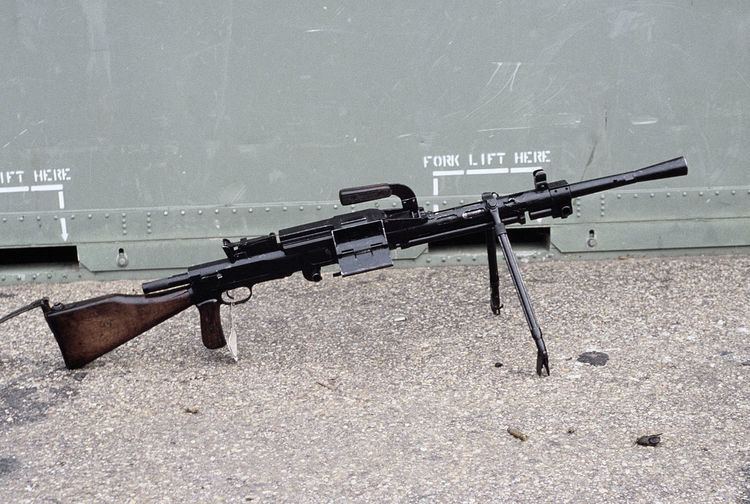Type Light machine gun In service 1928–1960s (USSR) | Used by See Users | |
 | ||
Wars Spanish Civil WarWinter WarWorld War IISecond Sino-Japanese WarKorean WarChinese Civil WarFirst Indochina WarVietnam WarLaotian Civil WarCambodian Civil WarCambodian-Vietnamese WarRhodesian Bush WarSino-Vietnamese WarYugoslav WarsSomali Civil War2011 Libyan civil warSyrian civil warUkranian civil war | ||
The Degtyaryov machine gun (Russian: Пулемёт Дегтярёвa Пехотный Pulemyot Degtyaryova Pekhotny "Degtyaryov's infantry machine gun") or DP is a light machine gun firing the 7.62×54mmR cartridge that was used primarily by the Soviet Union starting in 1928. The DP machine gun was supplemented in the 1950s by the more modern RPD machine gun and entirely replaced in Soviet service by the general purpose PK machine gun in the 1960s.
Contents
Design
The DP-27 was an improvement of the earlier DP-26, both designed by Vasily Degtyaryov. The DP-27 was relatively cheap and easy to manufacture – early models had fewer than 80 parts. The DP was especially able to withstand dirt in a reliable fashion. In tests it was buried in sand and mud and was still capable of firing more than 500 rounds. One of the DP's main drawbacks though was its bipod; it could not withstand much abuse and broke easily. Furthermore, the recoil spring was located under the barrel, around the gas piston; this was one of the design problems of the DP, since the spring tended to lose its temper due to overheating. Also, the only magazine option, a pan with 47 rounds that fed in from the top, was relatively small and continuous fire for long periods could not be relied on as much as contemporary belt-fed weapons. The ammunition was troublesome for automatic fire. Degtyarov had to use a flat pan magazine, which could feed those cartridges reliably, but was too heavy itself, uncomfortable to carry and prone to damage. Due to the design of the magazine, reloading an empty magazine with cartridges took a very long time. A redeeming factor was that the DP's lower cyclic rate of fire did reduce the risk of barrel overheating.
History
Despite its numerous problems, the DP had a reputation as a relatively effective light support weapon. It was nicknamed the "Record player" (proigryvatel') by Red Army troops because the disc-shaped pan magazine resembled a gramophone record and its top cover revolved while the weapon was fired. Many were captured by the Finnish army in the Winter War and the Continuation War and partially replaced the Lahti-Saloranta M/26. The DP received the nickname Emma in Finnish service after a popular waltz, again due to the magazine's resemblance to a record player. In the summer of 1944, the Finnish army had about 3400 Finnish-made Lahti-Salorantas and 9000 captured Soviet-made Degtyarevs on the front.
The Chinese Nationalists received 5,600 DPs from the USSR and used them in the Second Sino-Japanese War and the Chinese Civil War. The Chinese Communists used the DP in the Korean War and copied the DPM as the Type 53.
A number of the RP-46 variant of the DP have been spotted in present-day Somalia, in use with militant forces, and also among rebel forces in the 2011 Libyan uprising to overthrow Muammar Gaddafi.
DP-28's have also been recovered from Taliban fighters in Helmand Province, Afghanistan as recently as 2014.
DPs or DPMs have been spotted in 2014 in the Northern Mali conflict.
Variants
The original DP is more commonly called the DP-28 (or DP-27), although there is some confusion as to whether these are official designations or not.
